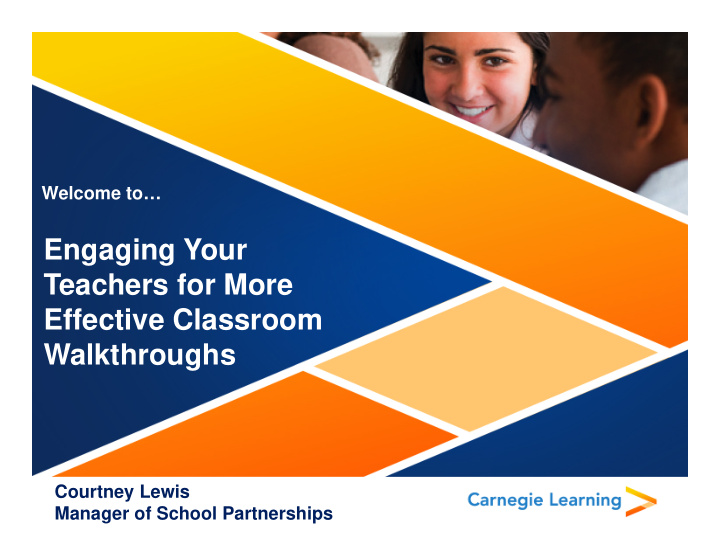



Welcome to… Engaging Your Teachers for More Effective Classroom Walkthroughs Courtney Lewis Manager of School Partnerships
LEARNING GOALS FOR SESSION • Gain an overview of the Classroom Walkthrough process • Discuss the key characteristics of Classroom Walkthroughs • Look at ways to engage the teacher in walkthroughs • Review tools and resources to support implementation of Classroom Walkthroughs
RESOURCE A study of 40 schools in the United States and Canada, and how administrators and teacher leaders moved teachers from resisting to embracing the practice. Authors: Donald S. Kachur, Judith A. Stout, Claudia L. Edwards
QUICK SURVEY • How familiar are you with Classroom Walkthroughs (CW)? 1. Not familiar a. Never experienced a CW 2. Somewhat familiar a. Heard of CWs b. Read about them c. Observed as part of a CW 3. Familiar a. Participated in CW b. Read resources on CW thoroughly
WHAT ARE CLASSROOM WALKTHROUGHS? • Purposeful, short, and frequent informal classroom visits to gain a snapshot into the level of student engagement and instructional practices used • Typically led by administrators, district level personnel, school improvement team members • Followed by an opportunity to reflect on what was observed, analyze data collected and identify next steps (Kachur, Stout, & Edwards, 2013).
PURPOSE OF CLASSROOM WALKTHROUGHS • Build common vision of learning and instruction • Assess the level of curriculum and instruction • Initiate dialogue about ways to improve instruction and learning • Expand relationships among those in the building involved in instruction and learning- administrators, teachers, and students
BENEFITS OF CLASSROOM WALKTHROUGHS • Increased student achievement • Improved instructional practices • More focused professional development sessions
COMMON VISION FOR INSTRUCTION & LEARNING From Shift focus To Working in isolation Increased collaboration Focusing on Teaching Focusing on Learning Differences in Practices Shared Practices Judgments Descriptions Pockets of Excellence Scaled Success City, E., Elmore, R., Fiarman, S., & Teitel, L. (2009).
BASIC ELEMENTS • Determine visit focus • Identify participants • Classroom visits of 5-15 minutes • Data Collection • Reflection/Feedback • Next Steps/Follow up
STAGES OF CLASSROOM WALKTHROUGH PROCESS Self Assessm ents Define/ Next Redefine Steps/Actio n Plan Focus Review Conduct Data & CW Reflect
COMMON CLASSROOM WALKTHROUGH MODELS • Data in a Day • Instructional Practice's Inventory Instructional Rounds Network • Instructional Rounds • Learning Walk Routine • Look 2 Learning (L2L) • McRel Power Walkthrough • Teachscape’s Reflect Classroom Walkthrough • UCLA Center X Classroom Walkthroughs
WAYS TO ENGAGE TEACHERS • Build culture of collaboration • Partner teachers with other teachers and administrators during the walkthroughs • Ensure the use of data is non-evaluative for teachers • Incorporate immediate time afterwards for reflection • Share specific, targeted feedback • Start small, scale up
WAYS TO ENGAGE TEACHERS Build a Culture of Collaboration • Important Components • Leadership • Shared Leadership • Established trust and safety to take risks • Student centered staff • Continuous learners seeking help from each other
WAYS TO ENGAGE TEACHERS Partnerships Among Teachers, Administrator • Encourage learning communities where • Teachers work together to share experience, knowledge, practices; provide genuine feedback • Administrators work with teachers to share experience, problem solve and collaborate around areas of need as well as celebrate successes • Open door policies to troubleshoot and problem solve as needed
WAYS TO ENGAGE TEACHERS Non-Evaluative Process • Establish a safe, no judgment zone • Focus on using data for professional growth opportunities • Critical to consider how the feedback will be provided • Examples: • No teacher names used during follow up discussions • Discuss trends and patterns observed
WAYS TO ENGAGE TEACHERS Non-Evaluative Process • Focus on school improvement • Share leadership with teachers • Establish norms and use protocols • Focus data on what is seen and heard during observations
WAYS TO ENGAGE TEACHERS Save Time for Reflection • Key to improving teaching and instruction • Allows opportunity to build action plan • Encourage sharing teacher to teacher and teachers to administrators • Use collective knowledge to problem solve • Incorporate questions to guide reflection • Set goal for all teachers to move towards self reflection
WAYS TO ENGAGE TEACHERS Share Specific, Targeted Feedback • Teacher to teacher • Administrator to teacher • Administrator to staff
WAYS TO ENGAGE TEACHERS Start Small, Scale Up • Teacher volunteers • Target influential teachers
WAYS TO ENGAGE TEACHERS: REVIEW • Build culture of collaboration • Partner teachers with other teachers and administrators during the walkthroughs • Ensure the use of data is non-evaluative for teachers • Incorporate immediate time afterwards for reflection • Share specific, targeted feedback • Start small, scale up
“ The greatest challenge that most students experience is the level of competence of the teacher.” -Dr. John Hattie, 2010 “School leadership is second only to classroom teaching as an influence on pupil learning.” - Leithwood, K., et al. (2007)
SAMPLE RESOURCES
SAMPLE RESOURCES
• What questions do you have? Q & A
REFERENCES Kachur, D. S., Stout, J. A., & Edwards, C. L. (2013). Engaging teachers in classroom walkthroughs . Association for Supervision & Curriculum Development: Alexandria, VA. City, E., Elmore, R., Fiarman, S., & Teitel, L. (2009). Instructional rounds in education. Harvard Education Press: Cambridge, MA. Protheroe, Nancy. (2009, March/April). Using classroom walkthroughs to improve instruction. Principal , 30-34.
THANK YOU Courtney Lewis Manager of School Partnerships CLEWIS@carnegielearning.com pd@carnegielearning.com
Recommend
More recommend